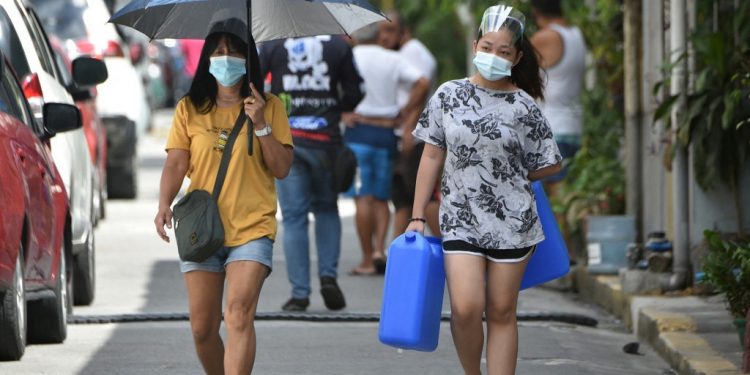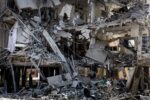IATF released implementing guidelines on new alert level as Metro Manila shift to localized lockdown starting September 16.

FILE PHOTO
The Inter-Agency Task Force (IATF) on Covid-19 has released the final guidelines on the implementation of pilot alert system for Metro Manila, as the country’s capital shifts to localized lockdown starting Thursday (September 16).
“We should strive for total health and this can only be realized by carefully balancing our COVID-19 response by considering both the health of our people and the economic health of the nation,” presidential spokesperson Harry Roque said in a statement.
Nationwide, strict and lengthy lockdowns since last year have remove large percentage of Philippine economy, which was one of Asia’s fastest growing before the pandemic.
Under the new quarantine guidelines, areas will be placed in either Alert Levels 1, 2, 3, 4, or 5.
Areas under Alert Level 5 are where numbers of COVID-19 cases are deemed alarming, and hospital and intensive care utilization rates are in critical stage. Guidelines applicable to enhanced community quarantine, the strictest lockdown level, will be implemented.
Areas where Alert Level 4 is hoisted have high or increasing COVID cases, with high utilization of their hospital and intensive care.
Minors, people above 65 years old, individuals with comorbidities and immunodeficiencies, and pregnant women are not allowed to go out in areas under Level 4, “provided, that they shall be allowed access to obtain essential goods and services, or for work in permitted industries and offices.”
People not in those categories may be allowed to travel within and outside of areas under Level 4, subject to the regulation of their destination’s LGU.
Outdoor exercises are allowed for residents, regardless of health and vaccination status, but they shall only be limited in moving within their village or barangay. They should also observe basic COVID-19 protocols, such as wearing facemasks and avoiding crowds.
The following establishments and activities are not allowed in areas under Alert Level 4:
- indoor tourist attractions, libraries, museums, archives, galleries, exhibits, cultural shows
- indoor venues for meetings, conferences, events
- cinemas, karaoke bars, clubs, concert halls, theaters
- outdoor and indoor amusement parks, fairs, playrooms, kiddie halls, playgrounds
- internet cafés, billiard halls, bowling alleys, amusement arcades,
- face-to-face classes, in-person examinations and other education-related activities at all levels
- casinos, horse racing, cockfighting, cockpits, lottery, betting shops
- concerts, wedding receptions or anniversaries, engagement parties, debut and birthday parties, family reunions, bridal or baby showers, parades, procession, residential gatherings, motorcades
- indoors sports venues, fitness studios, gyms, spas, public swimming pools, leisure centers
- all contact sports except those conducted under a “bubble-type” setup permitted by the IATF
- medical aesthetic clinics, cosmetic clinics, tattoo salons, and other personal care services including home services
- specialized markets of Department of Tourism
Under Level 4, outdoor or al fresco dine-in services will be permitted at 30 percent capacity. Indoor dine-in services will only be allowed at 10 percent capacity and can only cater to those fully vaccinated against COVID-19.
Personal care services only limited to barbershops, hair spas, nail spas, and beauty salons are allowed to operate also at 30 percent capacity if they operate in an outdoor setting. If they function indoors, only 10 percent of seating capacity is allowed.
Religious gatherings are also granted to be conducted in the same condition. Processions and similar services are not be allowed. Necrological services, meanwhile, will be only attended by immediate family members, provided the cause of death was not COVID-19.
Government offices will also operate at least 20 percent capacity under Level 4 areas.
In areas under Level 3, where numbers of COVID-19 cases are high with increasing hospital utilization, travel will be allowed for everyone “except for reasonable restrictions based on age and comorbidities” as determined by the respective LGU.
Outdoor exercises will also be allowed, regardless of health and vaccination status.
Establishments and activities not allowed under Level 4, especially those indoors, will be allowed under Level 3 at 30 percent capacity.
However, indoor entertainment venues like cinemas, theaters, bars, clubs, concert halls, amusement parks, theme parks, playrooms, playgrounds, and kiddie rides remain prohibited.
Government offices can operate at 30 percent capacity under Level 3 areas.
Meanwhile, in areas under Alert Level 2, where COVID-19 infections are low and decreasing but hospital utilization rates are increasing, travel and movement conditions are similar to Level 3. Individual outdoor exercises are also permitted regardless of health and vaccination status.
Establishments and activities allowed in Level 3 places are also allowed to operate at 50 percent capacity under Level 2 areas. Indoor entertainment venues like cinemas, theaters, bars, clubs, concert halls, amusement parks, theme parks, playrooms, playgrounds, and kiddie rides are also permitted.
Government offices are allowed to operate at 50 percent capacity under Level 2 areas.
Areas under Alert Level 1, where infections and hospital utilization rate is low, travel and movement are generally unrestricted except in activities and spaces that are crowded or enable close contact.
All establishments and activities are allowed at 100 percent capacity, provided they observe basic COVID-19 protocols.
Alert levels, meanwhile, will only be identified by the Department of Health. Identification or re-classifications of areas will be done weekly.
Restrictions and allowed establishments and activities in a certain can change, however, if a granular lockdown is declared by the LGU in a certain area of a city or province.
Strict quarantine measures will be implemented in that particular area, regardless of its city or province’s alert level, due to its identifications as a “critical zone” by the LGU.
Authorized persons outside residences (APORs) are still not allowed to go out in and out of areas under granular lockdown, except for healthcare workers and other medical personnel.
OFWs, either traveling abroad or returning home, are allowed to move in and out of areas under granular lockdown. Residents in areas under the quarantine measure are also allowed to return but must remain at home until the lockdown is lifted.
Residents with urgent medical issues and other such circumstances are also allowed to go out for medical checkups.
Food and essential items intended for a residence in an area under granular lockdown will be delivered to a designated point by the LGU.
Granular lockdowns last at least 14 days.
According to the IATF, households under granular lockdown must be provided assistance by the LGU and the Department of Social Welfare and Development.






